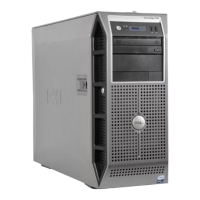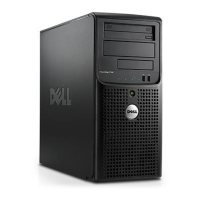Dell
PowerEdge T310 Technical Guide
8.7 Compatibility Module
The DMA controller incorporates the logic of two 82C37 DMA controllers, with seven independently
programmable channels. Channels 0–3 are hardwired to 8-bit, count-by-byte transfers, and channels
5–7 are hardwired to 16-bit, count-by-word transfers. Any two of the seven DMA channels can be
programmed to support fast Type-F transfers.
Channel 4 is reserved as a generic bus master request.
The Intel 3420 chipset supports LPC DMA, which is similar to ISA DMA, through the Intel 3420‘s DMA
controller. LPC DMA is handled through the use of the LDRQ# lines from peripherals and special
encoding on LAD[3:0] from the host. Single, Demand, Verify, and Increment modes are supported on
the LPC interface.
The timer/counter block contains three counters that are equivalent in function to those found in
one 82C54 programmable interval timer. These three counters are combined to provide the system
timer function. The 14.31818 MT/s oscillator input provides the clock source for these three counters.
The Intel 3420 chipset provides an ISA-Compatible Programmable Interrupt Controller (PIC) that
incorporates the functionality of two, 82C59 interrupt controllers. The two interrupt controllers are
cascaded so that 14 external and two internal interrupts are possible. In addition, the Intel 3420
chipset supports a serial interrupt scheme.
All of the registers in these modules can be read and restored. This is required to save and restore
system state after power has been removed and restored to the platform.
8.8 USB Controllers
The Intel 3420 chipset supports 12 USB 2.0 ports that support high-speed, full-speed, and low-speed
USB devices. The chipset contains up to two EHCI Host Controllers (EHCI#1 with eight ports and
EHCI#2 with six ports) and up to seven Universal Host Controller Interface (UHCI) controllers that
support USB full-speed and low-speed signaling. Each EHCI has an integrated USB 2.0 Rate Matching
Hub (RMH). The RMHs replace the functionality of the UHCI controllers by converting high-speed
traffic into low- and full-speed traffic. When the RMHs are enabled, the UHCI controllers are disabled.
8.9 Real-time Clock
The Intel 3420 chipset contains a Motorola MC146818A-compatible real-time clock (RTC) with 256
bytes of battery-backed RAM. The real-time clock performs two key functions: keeping track of the
time of day and storing system data, even when the system is powered down. The RTC operates on a
32.768KHz crystal and a 3V battery.
The RTC supports two lockable memory ranges. By setting bits in the configuration space, two 8-byte
ranges can be locked to read and write accesses to prevent unauthorized reading of passwords or
other system security information. The RTC supports a date alarm that allows for scheduling a wake
up event up to 30 days in advance, rather than just 24 hours in advance.
8.10 Enhanced Power Management
The power management functions include enhanced clock control and various low-power (suspend)
states (e.g., Suspend-to-RAM and Suspend-to-Disk). A hardware-based thermal management circuit
permits software-independent entrance to low-power states. The Intel 3420 chipset contains full
support for the Advanced Configuration and Power Interface (ACPI) Specification, Revision 3.0a.

